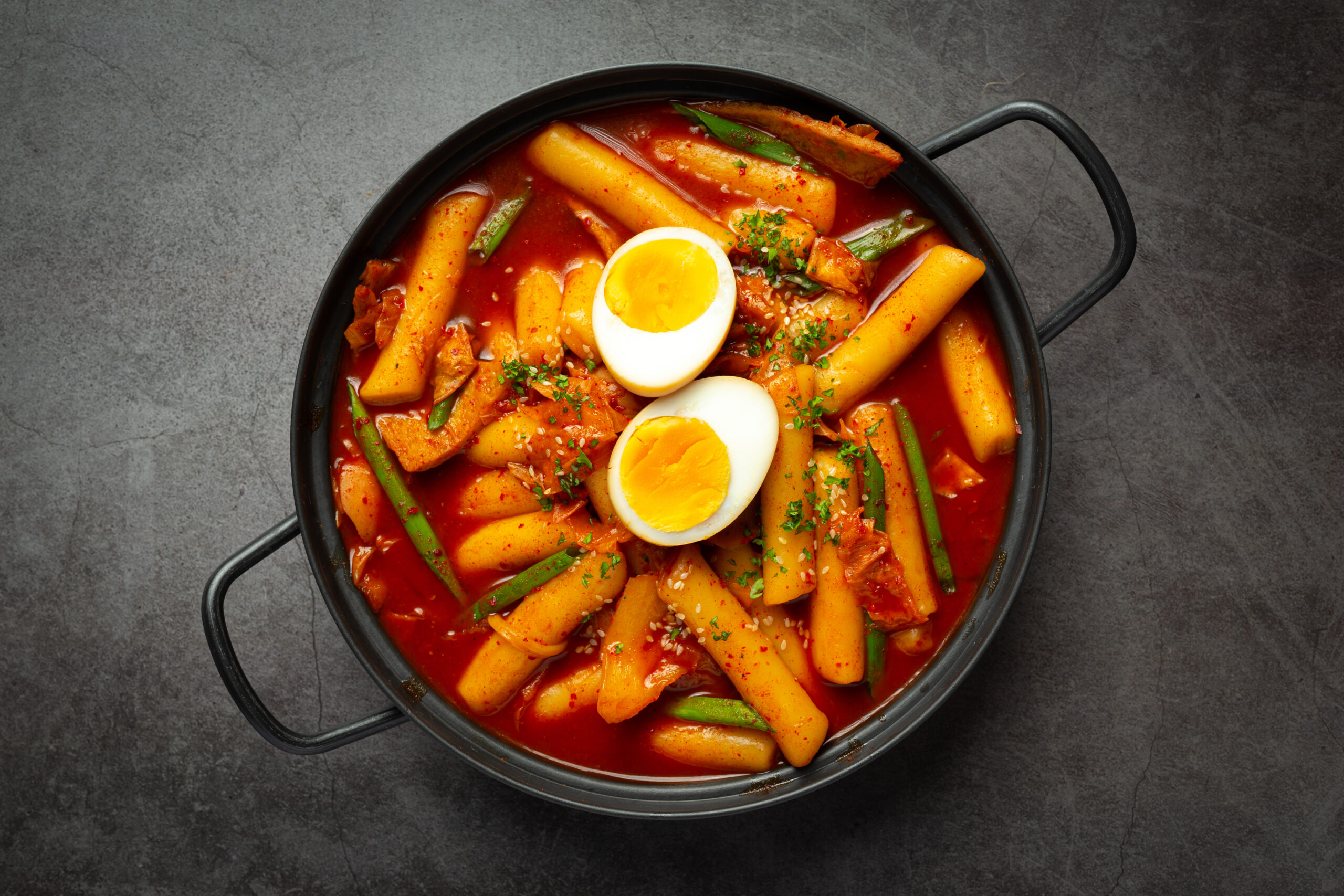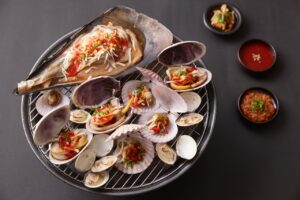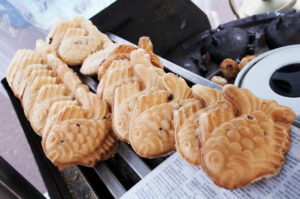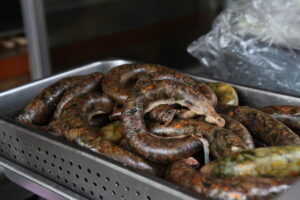
Cheesy Tteokbokki korean traditional food on black board background. Lunch dish.
What is Ttekbokki?
Tteokbokki (떡볶이) is a popular Korean street food and a beloved dish in Korean cuisine. It consists of chewy rice cakes (called tteok) that are cooked in a spicy and flavorful sauce made primarily with gochujang, a Korean red chili paste. The dish is often garnished with other ingredients like fish cakes (oden), boiled eggs, and scallions.
The meaning of the name
The key ingredient, tteok (rice cakes), is made from glutinous rice flour and water, resulting in a chewy and slightly sticky texture. Tteokbokki rice cakes are cylindrical or oval in shape and are available in various sizes and thicknesses, depending on personal preference and regional variations.
The spicy sauce used in it is made by combining gochujang (Korean red pepper paste), soy sauce, sugar, garlic, and sometimes other seasonings like sesame oil and black pepper. The combination of the fiery gochujang and the soft, chewy rice cakes creates a delightful contrast of flavors and textures.
It can be found in many forms, ranging from street food stalls to sit-down restaurants. It is a popular comfort food and a favorite snack among Koreans of all ages. While the classic version is spicy, there are also non-spicy variations available for those who prefer a milder taste.
In addition to the traditional version, tteokbokki has evolved over the years with various creative twists and additional ingredients. Some variations include adding cheese, seafood, instant noodles (ramyeon), or other vegetables to enhance the flavor and texture.
Tteokbokki is not only popular in Korea but has also gained popularity internationally, becoming a dish enjoyed by people around the world who appreciate its unique and addictively spicy taste. It’s definitely a must-try if you ever get the chance to explore Korean cuisine.
History of Tteokbokki
Tteokbokki (떡볶이) is a popular Korean dish made with chewy rice cakes that are stir-fried in a spicy and flavorful sauce. It has a history that spans several decades and has evolved from a simple street food to a beloved comfort dish enjoyed by people of all ages in Korea. Here’s a brief overview of the history of tteokbokki:
Origins and Early Forms: Tteokbokki’s origins can be traced back to the Joseon Dynasty (1392-1897), where it was initially known as “siru tteok” or “gungjung tteokbokki.” In its early forms, tteokbokki was enjoyed by the royal court and aristocracy as a dish made with sliced rice cakes, beef, vegetables, and soy sauce.
Post-War Changes: After the Korean War, during the mid-20th century, tteokbokki underwent significant changes. The dish began to evolve from its royal court origins into a more accessible street food. It transitioned from being a soy sauce-based dish to a spicy and gochujang (red chili paste) based dish, which is the version that’s widely recognized today.
Street Food and Popularization: Tteokbokki gained popularity as a street food in the 1950s and 1960s. Vendors would set up stalls in busy areas, selling tteokbokki to passersby. The dish’s affordability and satisfying flavors made it a favorite among students and working-class individuals.
Modernization and Variations: As South Korea’s economy and society developed, tteokbokki continued to evolve. The dish started to incorporate additional ingredients such as fish cakes, boiled eggs, and vegetables to enhance its flavors and textures. Different regions in Korea also developed their own variations of tteokbokki, adding unique ingredients and flavors to the dish.
Cultural Icon: Tteokbokki is now considered a quintessential Korean comfort food. It’s often enjoyed in various settings, from street food stalls and markets to restaurants and homes. It’s a dish that carries a sense of nostalgia for many Koreans, reminding them of their childhood and simpler times.
Global Popularity: Tteokbokki’s popularity has extended beyond Korea’s borders. Korean cuisine’s global rise in popularity has introduced tteokbokki to international audiences. Korean restaurants around the world offer their own interpretations of the dish, allowing people from different cultures to experience its unique flavors.
In summary, the history of tteokbokki reflects its evolution from a royal court dish to a beloved street food and comfort dish enjoyed by people from all walks of life. Its ability to adapt to changing times and tastes while maintaining its core elements has contributed to its enduring popularity both in Korea and beyond.
Cooking Method
Ingredients:
- 200g of tteok (rice cakes) – cylindrical or oval-shaped
- 1 cup of fish cakes (oden) – sliced into bite-sized pieces
- 2 cups of water
- 2 tablespoons of gochujang (Korean red chili paste)
- 1 tablespoon of soy sauce
- 1 tablespoon of sugar
- 2 cloves of garlic – minced
- 1 tablespoon of vegetable oil
- 1/2 cup of chopped scallions (green onions)
- Sesame seeds (optional, for garnish)
Instructions:
- Soak the tteok in cold water for about 20-30 minutes to soften them. Drain the water before using them in the dish.
- In a large saucepan or wok, heat the vegetable oil over medium heat. Add the minced garlic and stir-fry for about 30 seconds until fragrant.
- In a separate bowl, mix the gochujang, soy sauce, and sugar to make the spicy sauce.
- Add the spicy sauce to the saucepan/wok and stir to combine with the garlic.
- Pour in the water and bring it to a simmer. Let the sauce cook for a few minutes until it thickens slightly.
- Add the soaked tteok and fish cakes to the sauce, stirring gently to coat them evenly with the sauce.
- Continue simmering the tteokbokki on medium-low heat for about 10-15 minutes or until the rice cakes become soft and chewy, and the sauce thickens to your desired consistency.
- If the sauce becomes too thick, you can add more water to adjust the consistency.
- Add the chopped scallions and stir them into the tteokbokki.
- Serve the tteokbokki hot, optionally garnishing with sesame seeds for added flavor.
Note: Feel free to get creative with the ingredients. You can add other vegetables like sliced carrots, onions, or cabbage, and even some boiled eggs or instant noodles (ramyeon) to make a heartier version.
Recommended Place of Street Foods in Korea.
In Korea, you can find tteokbokki in various places, especially in bustling street food markets and popular tourist areas. Here are some common places where you can easily find street vendors and stalls selling tteokbokki:
- Myeongdong (명동): Myeongdong in Seoul is a famous shopping district and a popular tourist destination. Here, you’ll find numerous street food vendors selling tteokbokki along with other Korean snacks.
- Namdaemun Market (남대문시장): Namdaemun Market, also located in Seoul, is one of Korea’s largest traditional markets. It’s a great place to explore and try various street foods, including tteokbokki.
- Gwangjang Market (광장시장): Gwangjang Market, also in Seoul, is known for its vibrant food alley where you can find an array of Korean street food delights, including tteokbokki.
- Insadong (인사동): Insadong is a cultural district in Seoul, famous for its traditional crafts and street food. You’ll find tteokbokki along with other delicious snacks in the area.
- Dongdaemun Design Plaza (동대문디자인플라자): This modern architectural landmark in Seoul has various food stalls in its vicinity, offering tteokbokki and other Korean street foods.
- Busan Street Food Alley: Busan, South Korea’s second-largest city, has its own vibrant street food scene. You can explore street food alleys like Bupyeong Kkangtong Market and Gwangbokro Street to find tteokbokki and more.
- Traditional Markets: Besides the mentioned markets, almost every city and town in Korea has its traditional markets, which are excellent places to find street food vendors and stalls offering tteokbokki and other local delicacies.
- Street Food Festivals and Events: During certain times of the year, there might be street food festivals or events where vendors gather to showcase their culinary creations, including tteokbokki.
When you visit these places, keep an eye out for food carts, tents, or small stalls with signs displaying “떡볶이” or “Tteokbokki” in Korean. These vendors often offer other delicious street foods as well, so it’s an excellent opportunity to sample a variety of Korean snacks and treats. Enjoy the experience of exploring the diverse flavors of Korean street food!

작가 jcomp 출처 Freepik
Recommend to Read >> 2023 Korean Andong Jjimdak Recipe





